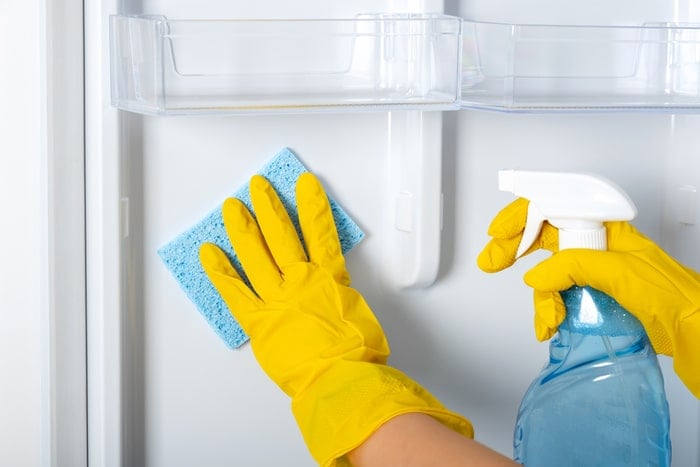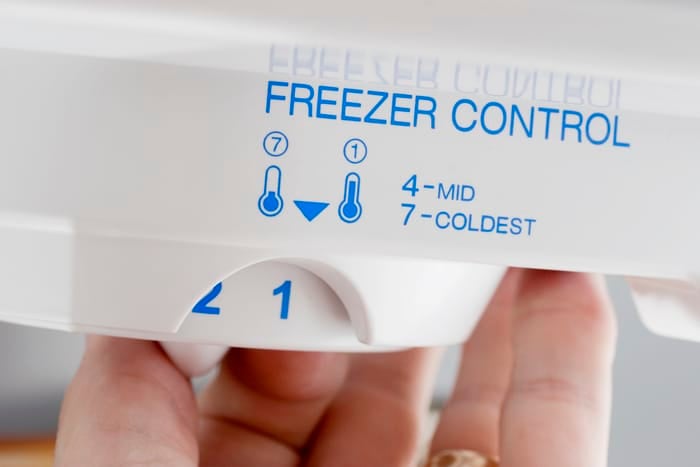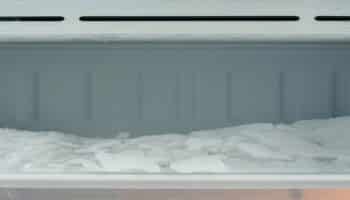Do you have a moldy freezer, and it’s stinking up your kitchen?
Sadly, I’ve been there too! There’s nothing more annoying than opening your freezer, only to find it has mold.
The good news is that you’ve come to the right place to get this issue fixed.
If you have a moldy freezer, you’ll need to use warm water and white vinegar to clean it. To prevent and stop mold growth. I recommend making sure the door is properly closed, cleaning up any water spills quickly, and checking the vents and temperature regularly.
Read on to learn more about these tips!
How to Clean a Moldy Freezer: 5 Simple Steps
If you notice that your chest, upright, or refrigerator freezer has mold, you’ll need to clean it immediately.
You see, mold can cause allergic symptoms, such as coughing, headaches, fatigue, runny nose, and others.
This is why I’ve prepared a list of 5 simple steps you should follow to clean a moldy freezer:
#1 Wear Protective Gear
As mentioned before, mold is dangerous to breathe. This is why you should always wear protective gear during the cleaning process (especially if you have allergies, asthma, or another respiratory disease).
To clean your moldy fridge, you’ll need to wear respiratory protection. If possible, use an N-95 face mask to keep small mold particles from reaching your mouth or nose.
I also recommend using gloves during the cleaning process. This way, you’ll protect your skin from contact with mold spores and from any irritating cleaner. Try using gloves that extend to the middle of the forearm.

Once you’ve put on your face mask and gloves, please unplug the freezer from the wall outlet or turn it off at the circuit breaker.
#2 Remove Items
Now, it’s time to remove all the frozen food. I recommend transferring it to a cooler during the cleaning process.
Although freezers can make your food last longer, frozen food doesn’t last forever. Try checking your food and discarding any items that have more than 3–6 months.
You should also take any removable shelves or drawers out of the freezer. Check your manual to know which parts are removable.
Bear in mind that if your freezer has ice buildup, you’ll need to defrost it before cleaning it.
If you can’t find your manual, please locate the label that includes the model number. In chest freezers, it’s usually located under the lid, on the inside wall, or on the sides or back of the unit.
But, if you have an upright freezer, the label may be located on the sealing or behind the lower kick plate. And, if you have a refrigerator-freezer, please search for the label on the sides, doors, or back.
Once you’ve found the label, please go to Google and search for your freezer’s model number and brand. For example, if you have a Whirlpool freezer, you’ll need to search for “Whirlpool Freezer [model number] manual PDF”.
Then, download the manual.
#3 Prepare the Cleaning Solution
Although bleach and other commercial cleaners can help you get rid of the mold in your freezer, I don’t recommend using them.
You see, they contain harsh chemicals that can transfer to food and harm the materials of the freezer’s interior.
This is why natural cleaners are the best way to go when cleaning a moldy freezer.
Try mixing equal parts of white vinegar and warm water in a spray bottle. Vinegar is inexpensive and a great cleaner for mold due to its acidity and antifungal/antimicrobial properties.

#4 Clean the Freezer
Once you’ve prepared the natural cleaning solution, it’s time for us to spray the inside of your freezer.
I recommend letting the solution sit for 15–30 minutes to give it time to take action, so you can easily clean the mold and get rid of any bad odors.
Then, use an old toothbrush or a sponge to scrub the trouble spots. Clean all the other compartments with a microfiber cloth.
Don’t forget to clean the ice dispenser, lid, baskets, and door seal thoroughly, since mold can quickly grow in them.
You may need to use a cotton swab to clean hard-to-reach spots.
Remember to clean all the shelves and drawers you previously removed. You can also use the natural cleaning solution. Then, rinse with water.
#5 Dry Your Freezer
Mold can grow in less than 48 hours in places with a lot of moisture and poor air circulation.
This is why, once you’ve cleaned your freezer, you’ll need to use paper towels to dry the interior, shelves, and drawers thoroughly.
This way you’ll avoid mold spores from spreading.
Once your freezer is completely dry, please throw away the paper towels or rags you’ve previously used to remove mildew.
Then, put the removable shelves and drawers back in place and plug your freezer back into the wall outlet.
How to Prevent Mold in the Freezer? 6 Quick Tips
Now that we’ve covered how to get clean a moldy freezer, it’s important to learn how to prevent mold from growing and spreading again.
This way, you will not only take care of your health, but you will also extend the lifespan of your freezer and save money on repairs.
Here are 6 simple tips that will help you prevent mold:
#1 Keep the Doors Closed
Excess moisture can happen if warm air mixes with the cold air inside your freezer. And, as you know, mold can easily grow in damp environments.
This is why you should only open the door when necessary and check the seals regularly.
You see, if the door gasket is broken, dirty, or worn out, the door won’t properly close, and warm air can easily get into your appliance.
If you notice that the door seal is damaged, please replace it with a new one. But, if it’s only dirty, clean it with equal parts of vinegar and warm water.
If you want to get any replacement part – or see how much one would cost – click to enter your model number in the search bar below. Our partners at AppliancePartsPros stock almost every part with free guides on how to install them.

#2 Make Sure Your Freezer Is Set to the Correct Temperature
If your freezer is not set to the correct temperature, your food may thaw and spoil and the ice can melt, which can lead to water residues and, of course, mold.
To check your freezer’s temperature, place a thermometer in ice cream that has been in the freezer for at least 12 hours.
Freezers should be set to 0 °F (ca. -18 °C). So, if yours is not set to the correct temperature, please adjust the temperature knob.

#3 Check the Vents Regularly
You should also check your freezer’s vents regularly to make sure it has proper air circulation.
This way, airflow can dry up excess moisture and prevent mold from growing and spreading.
Try locating the vents in your freezer and re-organizing the items to make sure there are no bottles or other containers blocking the vents.
#4 Inspect the Contents Regularly
As mentioned before, frozen food doesn’t last forever.
This is why you should take some time every month to check the food containers inside your freezer.
Please discard any items that have more than 3–6 months in your freezer and any other food that you suspect is spoiled.
Put any spoiled items in thick garbage bags, separated from other trash items.
#5 Clean Up Spills Quickly
Liquids on shelves or drawers could explain why mold keeps growing in your freezer.
To prevent this issue from happening again, regularly check if there’s any excess water, and clean up any spills quickly and completely.
Try using paper towels or a microfiber cloth to dry your freezer.
#6 Deep Clean Your Freezer Every Two Months
Deep cleaning your freezer is part of the maintenance process that will help you extend your appliance’s life span and prevent mold.
Try deep cleaning your freezer every two months with a natural cleaner (equal parts of vinegar and warm water).
But, remember, if your freezer is leaking water, you’ll need to clean it immediately.
Conclusion
That about covers it! I hope that this article has helped you clean and prevent mold in your freezer.
If you take anything away, remember to clean your freezer with warm water and vinegar to get rid of mold.
Don’t forget to keep the doors closed, check the internal temperature and vents, inspect the contents regularly, and clean up spills quickly to prevent mold.
Thank you so much for taking the time to read this article. Please check out our related content below if you found the tips above helpful.
Good luck!






